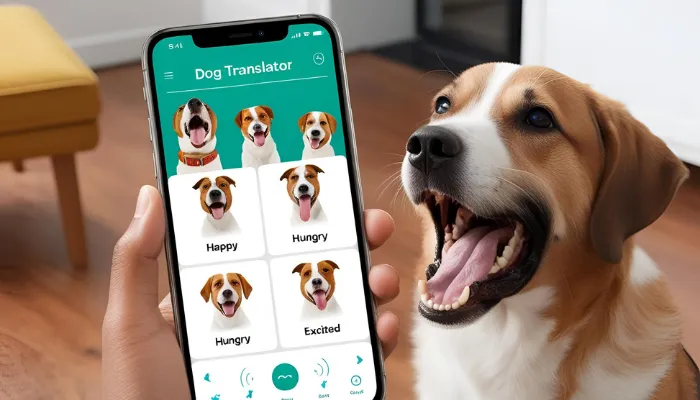What Is Sorry in Dog Language? Dogs are deeply communicative creatures who express themselves to their human companions through body movement, sounds, and actions. Have you ever thought about how dogs show contrition or the act of yielding? Don’t worry, you aren’t the only one.
Have you ever wondered if a dog translator could help decode their feelings? Learning these things helps to build stronger relationships between you and your pet. Even though dogs would not understand apologies like humans do, there are actions that they do which show admission of guilt or efforts to make things right.

How Do Dogs Express Apology?
What Is Sorry in Dog Language? Unlike humans, dogs don’t verbalize apologies. Instead, they rely on subtle and instinctive behaviors to signal remorse. Here are some common ways dogs express an apology-like behavior:
- Tucked Tail– A lowered or tucked tail signals submission and regret.
- Avoiding Eye Contact– A dog will look elsewhere or lower their gaze to showcase deference.
- Flattened Ears– Remorse can be exhibited by flattening their ears against their heads.
- Licking You– Dogs lick their owners as a form of showing submission and seeking reassurance.
- Rolling Over– Exposing the belly is a harmless sign which can mean they mean no offense.
- Pawing or Nudging– Dogs sometimes have very different and unique ways of asking for forgiveness by way of gently nudging you with their nose or pawing at you.
- Whining or Soft Barking– Attempts to reconcile or appease will often be marked by a softer tone of vocalization.
Dogs’ emotions are better understood by understanding these behaviors. In doing so, the bond between the owner and dog strengthens.
Why Do Dogs Apologize?
Dogs exhibit pack behavior, which means they have a specific social structure which is respected by all members in the group. This means that their packs, which include humans, also requires this sense of structure. This is the reason that they exhibit “apology” behaviour:
- Avoiding Conflict – Dogs will kneel in subordination so that they do not receive emotional or physical scolding.
- Seeking Reassurance – If a member of the pack seems to be angry, they will undertake actions which can regain their member’s favour.
- Responding To Your Reaction – Canines are very attentive and responsive towards humans and their postures, and so adjust their pitch and energy to match yours.
- Instinctive Pack Behavior – In a group of animals, to avoid conflict and ensure order, those who are weaker show submission to stronger members.
Understanding these instincts can help you respond to your dog in a way that reinforces trust and positive behavior.
Signs Your Dog Feels Guilty
While dogs don’t feel guilt the way humans do, they can recognize when they’ve done something that leads to negative consequences. What Is Sorry in Dog Language? It’s a combination of submissive behaviors and body language that dogs use to appease their owners. Below is a comparison of common “guilty dog” behaviors and their meanings:
| Behavior | Meaning |
|---|---|
| Head lowered | Submission and acknowledgment |
| Avoids eye contact | Avoiding confrontation |
| Tail tucked | Fear or insecurity |
| Whining | Seeking reassurance |
| Hiding | Avoiding perceived punishment |
| Ears pinned back | Apologetic or anxious demeanor |
Recognizing these signs can help you respond appropriately and strengthen your bond with your dog.
How to Respond When Your Dog Apologizes?
Considering your dog is doing things that seem like an apology, it is your duty to respond appropriately to prevent any negative effects. Here is the guide for positive engagement:
- Stay Calm – Refrain from screaming or looking angry as this is more detrimental than beneficial.
- Use a Soft Voice – You can provide reassurance to your dog by adopting a gentler tone.
- Give Gentle Affection – Soft speech and gentle caresses are great ways of displaying approval of good behavior.
- Redirect Their Energy – You can decree good behavior by telling them what they should be doing instead.
- Avoid Prolonged Scolding – Dogs focus on the present, so excessive admonishment can create more problems than solve.
By showing patience and adopting a positive manner, you can make your dog feel safe and encourage good behavior.
Can Dogs Recognize a Human Apology?
Many dog owners wonder, What Is Sorry in Dog Language? While dogs don’t comprehend apologies as humans do, they pick up on tone and body language. If you’ve accidentally stepped on your dog’s paw or raised your voice unnecessarily, here’s how to “apologize” to your dog:
- Speak Softly – A gentle and warm voice helps them understand the situation.
- Offer Reassurance through Touch – Physical contact such petting or belly rubbing helps strengthen the bond.
- Have Fun Together – Downtime with your dog assures them that all is well.
- Give Treats Sparingly – Although these are useful, excessive use may bestow negative behaviors and bad habits.
With this method, dogs are gently approached and the owner’s bond with the dog is further enhanced.
Conclusion
Grasping the meaning of What Is Sorry in Dog Language? strengthens your bond with your pet. Although dogs do not ‘say sorry’ in a human way, they do show their remorse alongside body language as well as submissive actions to soothe the owners.
Learning to identify those signals and responding to them positively serves to enrich the relationship. The next time your dog shows behavior that looks like they are saying sorry, make sure to acknowledge their feelings and reward them positively in order to continue the loving relationship.
